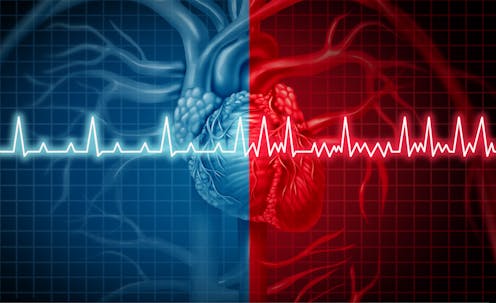
Atrial fibrillation, or A-fib, is an irregular heart rhythm that increases a person’s risk of stroke, heart failure and even premature death.
While many risk factors contribute to A-fib, one stands out for its growing prevalence worldwide: obesity.
I am a cardiology researcher, and my team and I uncovered key mechanisms contributing to the harmful effects of obesity on heart function. Targeting these processes may offer new avenues for treatment.
How obesity stresses the heart
Obesity is far more than a weight issue – it fundamentally alters the body’s biochemistry. This in turn changes your metabolism, or the chemical reactions that allow the body to function.
In particular, the increased presence of fatty acids, a hallmark of obesity, puts additional strain on heart cells. Fatty acids can directly damage heart cells by triggering the increased production of reactive oxygen species – specific molecules that can damage tissues and disrupt normal cellular functions. These effects result in a disruption of the heart’s electrical signals, leading to irregular beating.
One major source of reactive oxygen species is NOX2, an enzyme that becomes more active in people with obesity. NOX2 influences the activity of several key proteins that regulate the heart’s rhythm. It also contributes to oxidative stress in the atria – the heart’s upper chambers – altering their size, shape and function. This cardiac remodeling is a key driver of irregular heart rhythms.
A 2-pronged approach
My team and I set out to better understand how NOX2 affects the heart, and whether targeting it could reduce the risk of developing irregular heart rhythms among people living with obesity.
We approached this problem from two directions.
First, we used mice fed a high-fat diet to induce obesity similar to that in people. One group of these mice were able to produce functional NOX2 while another group could not. We tested drugs that specifically inhibit NOX2 and checked how likely the upper chambers of the heart were to develop irregular electrical rhythms.
In parallel, we generated human atrial heart cells from stem cells and treated them with fatty acids to simulate the effects of obesity. While our mouse model would capture the effects of obesity in the body as a whole, our cell model would enable us to study how it affects the heart at the cellular level.

We observed that increased NOX2 activity in both obese mice and treated human heart cells led to significant changes in the heart’s electrical properties. Obese mice without NOX2 had less severe atrial fibrillation than obese mice with NOX2. Similarly, obese mice treated with NOX2 inhibitors also showed improvements in the severity of their irregular heart rhythms, though to a lesser extent. And blocking NOX2 in heart cells exposed to fatty acids reversed the cellular changes caused by fatty acid treatment.
In both mice and human heart cells, inhibiting NOX2 reduced oxidative stress and normalized the heart’s electrical activity. This finding suggests that NOX2 plays a key role in the development of obesity-induced irregular heart rhythms.
Notably, we found that NOX2 plays a significant role in increasing the activity of a gene called PITX2, which is linked to changes in the heart’s electrical function. Our data showed that PITX2 activity was amplified in both obese mice and human heart cells, but reducing NOX2 activity directly lowered PITX2 levels. These findings suggest that oxidative stress and genetic factors play a role in the development of irregular heart rhythms.
Treating atrial fibrillation
Current treatments for atrial fibrillation, particularly for patients living with obesity, have focused more on managing symptoms than addressing the physiological changes that cause it.
Though far from reaching the clinic, our research suggests that targeting NOX2 could offer a new treatment strategy to prevent or reduce the severity of irregular heart rhythms. A further understanding of the genetic pathways involved in atrial fibrillation, such as PITX2, may lead to more personalized treatments in the future.
By delving into the molecular mechanisms behind irregular heart rhythms, researchers can develop more targeted approaches that address the root causes and improve outcomes for patients struggling with both obesity and heart conditions.
Arvind Sridhar does not work for, consult, own shares in or receive funding from any company or organization that would benefit from this article, and has disclosed no relevant affiliations beyond their academic appointment.
This article was originally published on The Conversation. Read the original article.







